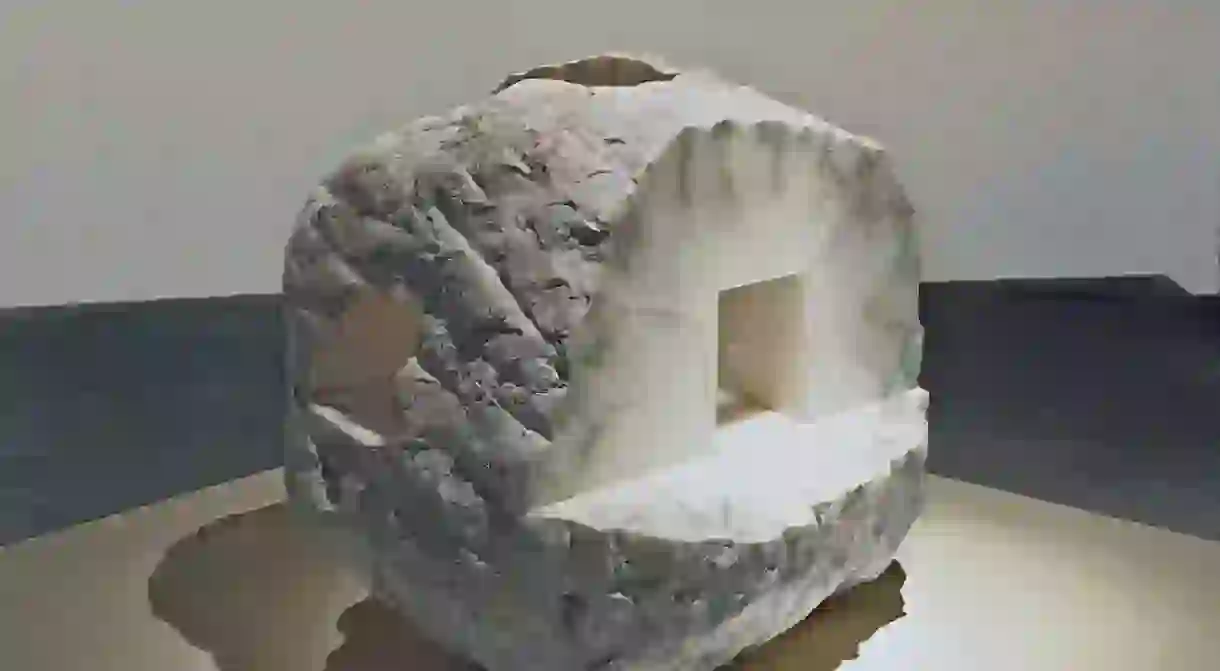Basque Sculptor Eduardo Chillida in his Artworks

Eduardo Chillida is one of the most celebrated Basque artists. Known for his large-scale sculptures, his work can be seen on display in museums, parks and public squares throughout the world. Born in 1924 in San Sebastián, he spent time in both Madrid and Paris, and often dedicated his pieces to public figures or commemorative events.
Did you know – Culture Trip now does bookable, small-group trips? Pick from authentic, immersive Epic Trips, compact and action-packed Mini Trips and sparkling, expansive Sailing Trips.
Gure Aitaren Etxea
Located in the town of Gernika, the sculpture Gure Aitaren Etxea, roughly translated as ‘Our Father’s House’ from Basque, was commissioned by the Basque government for the 50th anniversary of the bombing of the town by Nazi forces during the Spanish Civil War. It is situated around 200 metres from the Gernika tree and is supposed to be an open-house or boat, so as to be able to communicate with the tree.
How Profound is the Air
On display at the Guggenheim Museum in Bilbao, this unique sculpture was created in 1996 and is made of stone. Chillida left the rough natural exterior of the stone and sculpted the interior into smooth surfaces. The piece looks at how the solid relates to the void of time and space.

Eulogy to the Water
Like a giant claw suspended over an outdoor pool, Eulogy to the Water can be found in Barcelona’s Creueta del Coll Park. Created in 1987, the reflection of the sculpture in the water is supposed to represent the myth of Narcissus. Today, it is admired each summer by the citizens of Barcelona who come to swim and paddle in the pool.
Homage to Fleming
Located along the Paseo de Concha in the Basque city of San Sebastián, this sculpture pays homage to Alexander Fleming, who invented penicillin. It was created in 1955 from iron, the year that Fleming died, and was later recreated in granite in 1990.
Monument to Tolerance
Located in the Andalusian city of Seville, Monument to Tolerance can be found next to the Triana Bridge. Completed in 1992 to coincide with the Universal Exposition of Seville, it was commissioned by The Friends of Sefarad Foundation for the Sephardic Jews. It commemorates the Edict of Granada in 1492, in which the Spanish Catholic kings expelled the Jews from their kingdoms. Upon its unveiling, Chillida said: “It is not my intention to give any example to anyone, but it would be perfect if one day in Seville the Jewish people, the Arab and the Christian would again shake hands. That is precisely the idea that reflects the monument.”
Buscando La Luz
Buscando La Luz, or ‘Looking for the Light’, can be found in the German city of Munich. It was completed in 2002 at the opening of the Pinakothek der Moderne art complex. Consisting of three undulating iron funnels, it is the largest of Chillida’s sculptures.
Homenaje a Braque
Created in 1990, this sculpture pays homage to Georges Braque – a 20th-century painter, printmaker, sculptor and collagist. He was at the forefront of the Cubism movement and is perhaps best known for his collaboration with Pablo Picasso in the invention of papier collés – a pasted paper collage technique that the two artists invented in 1912. The sculpture is housed in the sculpture park at the Chillida-Leku Museum, found just outside the city of San Sebastián; however, it has been temporarily closed to the public.
Peine del Viento
One of Chillida’s most celebrated works, Wind Comb can be found along the seafront in San Sebastián. It was created in conjunction with the architect Luis Peña Ganchegui and comprises two iron claws or combs, reaching out into the sea. The sculpture successfully fuses together the fierceness of the waves and the strength of the iron structures to create a powerful piece.
Space Spheres of Peace
Located in the city of Lund in southern Sweden, this piece sits pride of place in the main square. Completed in 1972, it is known as Rymdfält av fred in Swedish,andwas commissioned by the city council to represent peace.
Eulogy to the Horizon
Found in the city of Gijón in Asturias, on top of the hill of Santa Catalina, this is one of the city’s most famous sights. Made from cement blocks, it was completed in 1990. Locals have nicknamed this sculpture ‘King Kong’s Water Closet’ because of its interesting shape.













